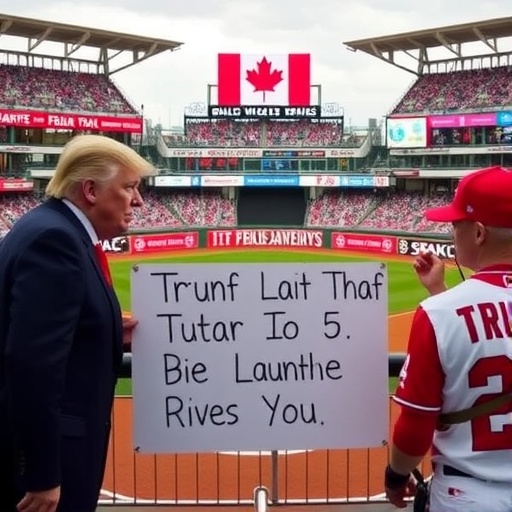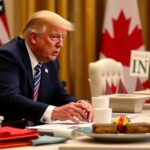Trump Hits Canada with 10% Tariff Increase Over Ontario’s Anti-Tariff World Series Ad Controversy
In a dramatic escalation of tensions between the United States and its northern neighbor, President Donald Trump has imposed an additional 10% tariff on all Canadian imports, directly retaliating against a provocative anti-tariff advertisement aired by the province of Ontario during Game 7 of the World Series. The move, announced late Friday from the White House, labels the ad as a “hostile act” and immediately halts ongoing trade talks with Canada, sending shockwaves through North American markets and raising fears of a broader trade war.
The advertisement, which featured stark imagery of American families burdened by higher prices due to tariffs, aired nationwide during the high-stakes baseball showdown between the Los Angeles Dodgers and New York Yankees. Ontario Premier Doug Ford defended the spot as a necessary public service announcement, but Trump wasted no time in framing it as an attack on U.S. economic sovereignty. “Canada thinks they can play games with our great American workers? Not on my watch,” Trump declared in a fiery statement, vowing to protect domestic industries from what he called “unfair Canadian aggression.”
This latest tariff hike builds on existing duties already in place from Trump’s first term, potentially adding billions to the cost of everyday goods like lumber, automobiles, and dairy products flowing across the border. Economists warn that the decision could disrupt supply chains and inflate consumer prices just as holiday shopping ramps up, affecting everything from Canadian maple syrup on U.S. breakfast tables to auto parts in Detroit factories.
Ontario’s World Series Ad: A Bold Stand Against U.S. Tariffs
The controversy ignited when Ontario’s government decided to air its anti-tariff ad during one of the most-watched events in American sports—the World Series. The 30-second spot, produced by the Ontario Ministry of Economic Development, opened with a family at a kitchen table, struggling to afford groceries amid rising costs attributed to U.S. tariffs on Canadian goods. “Tariffs hurt us all,” the narrator intoned, showing clips of shuttered factories in Windsor and frustrated farmers in rural Ontario. The ad concluded with a call to action: “Tell Washington: End the tariffs now.”
Costing an estimated $2.5 million to produce and air—funded through provincial taxpayer dollars—the advertisement was strategically timed to reach millions of U.S. viewers tuning in for the Fall Classic. Ontario officials claimed it was meant to educate Americans on the shared economic pain of protectionist policies, highlighting how Trump’s tariffs on steel and aluminum in 2018 had already cost Canadian exporters over $2 billion annually, according to a 2023 report from the Canadian Chamber of Commerce.
Premier Ford, speaking from Toronto’s Queen’s Park, stood firm in a press conference Saturday morning. “We’re not backing down. These tariffs are strangling our economy and hurting American consumers too. Ontario won’t stay silent while our workers suffer,” Ford said, emphasizing the province’s role as Canada’s economic powerhouse, responsible for 38% of the nation’s GDP and a key supplier of energy and manufacturing to the U.S. The ad’s timing during the World Series, with viewership peaking at 14.5 million for Game 7, amplified its reach, but it also crossed a line for the Trump administration, which views such public campaigns as interference in domestic politics.
Critics in Canada, including opposition leaders, questioned the ad’s effectiveness and cost. NDP Leader Marit Stiles called it “grandstanding at taxpayers’ expense,” while business groups like the Canadian Manufacturers & Exporters expressed concern that it could provoke exactly the response it aimed to prevent. Nonetheless, the ad struck a chord on social media, garnering over 500,000 views on YouTube within hours and sparking hashtags like #EndTheTariffs and #OntarioStandsUp.
Trump’s Retaliatory Tariff: Details and Immediate Economic Fallout
President Trump’s response was swift and uncompromising. In an executive order signed Friday evening, he directed the U.S. Trade Representative to impose an across-the-board 10% tariff on Canadian imports, effective immediately. This adds to the existing 25% duties on steel and 10% on aluminum from 2018, as well as targeted tariffs on softwood lumber that have been in place since 2017. The White House estimates the new tariffs will generate up to $16 billion in annual revenue, which Trump touted as a win for American taxpayers funding infrastructure and job training.
But the economic implications are far-reaching. Canada is the United States’ largest trading partner, with bilateral trade totaling $1.2 trillion in 2023, according to U.S. Census Bureau data. Key sectors hit hardest include Ontario’s auto industry, which exports $50 billion worth of vehicles and parts to the U.S. annually—more than any other Canadian province. The Ontario Ministry of Finance projects that the 10% hike could lead to a 5-7% drop in exports, potentially resulting in 20,000 job losses in manufacturing hubs like Oshawa and Windsor.
On the U.S. side, consumers could see price increases of 3-5% on imported Canadian goods, per a preliminary analysis from the Peterson Institute for International Economics. This includes everything from winter clothing made with Canadian wool to beer brewed north of the border. Retail giants like Walmart and Home Depot, which rely heavily on Canadian suppliers, issued statements warning of supply chain disruptions. “We’re monitoring the situation closely and will work to minimize impacts on our customers,” a Walmart spokesperson said.
Trump justified the move by invoking national security concerns, a tactic used in previous tariff actions. “Canada’s ad was a direct assault on our trade policies, and this tariff levels the playing field,” he stated during a rally in Pennsylvania, where he linked the decision to protecting steel jobs in the Rust Belt. The announcement also halts all ongoing trade negotiations, including talks under the USMCA framework aimed at resolving dairy and digital trade disputes.
Halting Trade Talks: A Blow to US-Canada Relations
The suspension of trade discussions marks a significant setback in the often-fragile U.S.-Canada relationship. Since the renegotiation of NAFTA into the United States-Mexico-Canada Agreement (USMCA) in 2020, both nations have worked to iron out lingering issues, including auto content rules and environmental standards. However, Trump’s decision to pull the plug comes at a critical juncture, with a USMCA review scheduled for 2026 looming on the horizon.
Canadian Prime Minister Justin Trudeau responded with measured outrage during a virtual address to the nation. “This is not how allies treat each other. We’re prepared to defend our interests through the WTO and other channels,” Trudeau said, alluding to potential retaliatory measures. Ontario, as a bellwether province, has been at the forefront of these talks, with Ford’s government lobbying for tariff exemptions on critical minerals needed for electric vehicle batteries.
Historical context underscores the stakes. The 2018 tariff spat between Trump and Trudeau led to tit-for-tat duties, costing U.S. exporters $1.4 billion in lost sales, according to the U.S. Chamber of Commerce. This time, the personal animus appears sharper, fueled by the ad’s public humiliation during a major U.S. sporting event. Diplomatic sources report that U.S. Ambassador to Canada Peter Hoekstra was summoned to Ottawa for emergency talks, but no breakthroughs were reported.
Broader geopolitical factors are at play. With U.S. midterm elections approaching, Trump is leveraging the tariff announcement to rally his base in manufacturing states like Michigan and Ohio, where anti-Canada sentiment runs high over lumber disputes. Meanwhile, Canada’s upcoming federal election in 2025 could see the trade issue dominate, potentially boosting nationalist voices in Quebec and Alberta.
Expert Voices and Market Reactions to the Tariff Escalation
Economists and trade experts are sounding alarms over the potential for a domino effect. Dr. Laura Johnson, a senior fellow at the Brookings Institution, described the tariffs as “a step backward in an already volatile global economy.” In an interview with Reuters, she noted, “The World Series ad was provocative, but Trump’s response risks alienating a key ally at a time when supply chains are still recovering from COVID-19 disruptions.”
Market reactions were immediate and stark. The Canadian dollar plunged 2.3% against the U.S. dollar on Friday, hitting a five-month low of 0.72 USD. Toronto’s TSX index dropped 1.8%, with energy and materials sectors—vital to Ontario’s economy—leading the decline. In the U.S., the Dow Jones Industrial Average shed 150 points in after-hours trading, dragged down by automaker stocks like Ford and General Motors, which source 30% of their parts from Canada.
Industry leaders weighed in with urgency. Mark Carney, former Bank of Canada governor, urged de-escalation in a Globe and Mail op-ed: “Tariffs are a blunt instrument that hurt everyone. Ontario’s ad may have been ill-timed, but retaliation only deepens the divide.” On the U.S. side, the Alliance for American Manufacturing praised Trump’s move, with President Scott Paul stating, “This sends a clear message: No more games with our trade partners.”
Social media amplified the divide, with viral memes depicting Trump as a baseball umpire calling “foul” on Canada, while Canadian users shared stories of cross-border families torn by economic uncertainty. Polling from Angus Reid Institute shows 62% of Canadians view the tariffs as unfair, up from 55% last year, while a Quinnipiac poll indicates 48% of Americans support tougher trade measures against Canada.
Future Implications: Navigating the Path to Trade Resolution
As the dust settles on this latest chapter in U.S.-Canada trade friction, the road ahead looks fraught with challenges. With trade talks frozen, both sides may turn to multilateral forums like the World Trade Organization, where Canada has already filed complaints against previous U.S. tariffs. Ontario’s government is exploring provincial-level incentives, such as tax breaks for exporters, to cushion the blow, while U.S. lawmakers from border states push for congressional oversight on executive tariff powers.
Long-term, experts predict this could accelerate diversification efforts. Canada is eyeing deeper ties with the European Union through CETA, potentially rerouting $10 billion in exports away from the U.S. market. For Trump, the tariffs serve as leverage ahead of his re-election bid, but they risk backlash if inflation spikes—current U.S. CPI stands at 3.2%, with imported goods contributing 0.5 points.
Optimists point to past resolutions, like the 2019 lifting of steel tariffs after intense negotiations. Yet, with personal barbs flying—Trump reportedly called Ford a “weak leader” in private calls—the path to détente may require high-level summits. As winter approaches, symbolizing the cold in bilateral relations, stakeholders on both sides of the border brace for a holiday season shadowed by economic uncertainty, hoping for a thaw before the new year.
The saga of Ontario’s ad and Trump’s tariffs underscores the fragility of North American trade in an era of populist politics. Whether this leads to constructive dialogue or further entrenchment remains to be seen, but one thing is clear: the stakes for workers, businesses, and consumers in Trump’s America and Canada’s heartland have never been higher.










